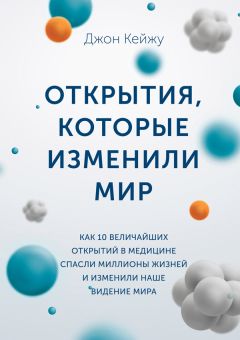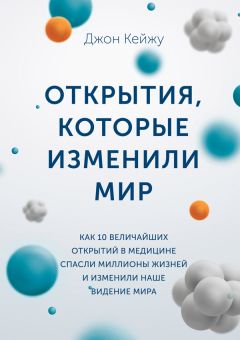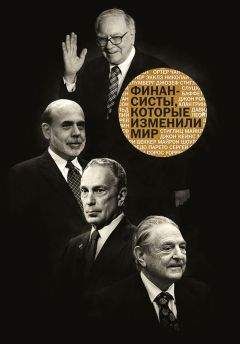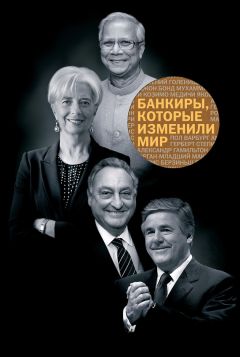Джон Кейжу - Открытия, которые изменили мир
На электронном книжном портале my-library.info можно читать бесплатно книги онлайн без регистрации, в том числе Джон Кейжу - Открытия, которые изменили мир. Жанр: Прочее издательство -, год 2004. В онлайн доступе вы получите полную версию книги с кратким содержанием для ознакомления, сможете читать аннотацию к книге (предисловие), увидеть рецензии тех, кто произведение уже прочитал и их экспертное мнение о прочитанном.
Кроме того, в библиотеке онлайн my-library.info вы найдете много новинок, которые заслуживают вашего внимания.

Джон Кейжу - Открытия, которые изменили мир краткое содержание
Открытия, которые изменили мир читать онлайн бесплатно
Глава 3
Bardell D. The roles of sense and taste and clean teeth in the discovery of bacteria by Antoni van Leeuwenhoek // Microbiological Reviews, 1982. Vol. 47. No. 1, March. Pp. 121–126.
Barnett J. A. Beginnings of microbiology and biochemistry: The contribution of yeast research // Microbiology, 2003. Vol. 149. Pp. 557–567.
Baxter A. G. Louis Pasteur’s beer of revenge // Nature Reviews Immunology, 2001. Vol. 1, December. Pp. 229–232.
Blaser M. J. Who are we? Indigenous microbes and the ecology of human diseases // European Molecular Biology Organization (EMBO) Reports, 2006. Vol. 7. No. 10. Pp. 956–960.
Carter K. C. Semmelweis and his predecessors // Medical History, 1981. Vol. 25. Pp. 57–72.
Carte, K. C. Koch’s postulates in relation to the work of Jacob Henle and Edwin Klebs // Medical History, 1985. Vol. 29. Pp. 353–374.
Centers for Disease Control and Prevention. Estimates of Healthcare–Associated Infections // www.cdc.gov/ncidod/dhqp/hai.html.
Centers for Disease Control and Prevention. Guideline for Hand Hygiene in Health-Care Settings. Morbidity and Mortality Weekly Report 51 (RR-16), 2002. October. Pp. 1–33.
Dunlop D. R. The life and work of Louis Pasteur // The Canadian Medical Association Journal, 1927. November. Pp. 297–303.
Dunn P. M. Ignac Semmelweis (1818–1865) of Budapest and the prevention of puerperal fever // Archives of Disease in Childhood. Fetal and Neonatal Edition, 2005. Vol. 90. Pp. F345–F348.
Elek S. D. Semmelweis and the Oath of Hippocrates // Proceedings of the Royal Society of Medicine, 1966. Vol. 59. No. 4, April. Pp. 346–352.
The Encyclopædia Britannica: A Dictionary of Arts, Sciences, Literature, and General Information. 11th ed. Volume XVI. Lister, Joseph. New York: The Encyclopædia Britannica Company, 191.
Fleming A. Louis Pasteur // British Medical Journal, 1947. April. Pp. 517–522.
Fleming J. B. Puerperal fever: The historical development of its treatment // Proceedings of the Royal Society of Medicine, 1966. Vol. 59, April. Pp. 341–345.
Fred E. B. Antony van Leeuwenhoek: On the three-hundredth anniversary of his birth // Journal of Bacteriology, 1933. Vol. 25. No. 1. Pp. 1–18.
Godwin W. Memoirs of Mary Wollstonecraft. London: Constable and Co., 1928 // http://dwardmac.pitzer.edu/anarchist_archives/godwin/memoirs/toc.html.
Goldmann D. System failure versus personal accountability — The case for clean hands // The New England Journal of Medicine, 2006. Vol. 355. No. 2, July. Pp. 121–123.
Gordon J. I., Ley R. E., Wilson R. et al. Extending our view of self: The human gut microbiome initiative (HGMI) // http://genome.gov/Pages/Research/Sequencing/SeqProposals/HGMISeq.pdf.
Kaufmann S. H. E. Robert Koch, the Nobel Prize, and the ongoing threat of tuberculosis // The New England Journal of Medicine, 2005. Vol. 353. No. 23, December. Pp. 2423–2426.
Kaufmann S. H. E., Schaible U. E. 100th anniversary of Robert Koch’s Nobel Prize for the discovery of the tubercle bacillus // Trends in Microbiology, 2005. Vol. 13. No. 10, October. Pp. 469–475.
Klevens R. M., Edwards J. R., Richards C. S., Jr. et al. Estimating health care associated infections and deaths in U.S. hospitals, 2002 // Public Health Reports, 2007. Vol. 122, March–April. Pp. 160–166.
Krasner R. I. Pasteur: High priest of microbiology // ASM News, 1995. Vol. 61. No. 11. Pp. 575–578.
Louden I. The Tragedy of Childbed Fever. Oxford University Press // https://global.oup.com/academic/product/the-tragedy-of-childbed-fever-9780198204992?cc=ru&lang=en&.
National Institutes of Health. NIH Launches Human Microbiome Project. December 19, 2007 // http://www.nih.gov/news-events/news-releases/nih-launches-human-microbiome-project.
Nobelprize.org. Robert Koch: The Nobel Prize in Physiology or Medicine, 1905 // http://nobelprize.org/nobel_prizes/medicine/laureates/1905/koch-bio.html.
Nuland S. B. The enigma of Semmelweis — an interpretation // Journal of the History of Medicine, 1979. July. Pp. 255–272.
Pasteur L. On Spontaneous Generation. Address delivered at the Sorbonne Scientific Soiree, April 7, 1864 // Revue des cours scientifics, 1864. Vol. 1. April 23. Pp. 257–264.
Porter J. R. Louis Pasteur: Achievements and disappointments, 1861 // Pasteur Award Lecture, 1961. Vol. 25. Pp. 389–403.
Porter J. R. Antony van Leeuwenhoek: Tercentenary of his discovery of bacteria // Bacteriological Reviews, 1976. Vol. 40. No. 2, June. Pp. 260–269.
Semmelweis I. The Etiology, Concept, and Prophylaxis of Childbed Fever. Trans. K. Codell Carter. Madison, WI: The University of Wisconsin Press, 1983.
Tomes N. J. American attitudes toward the germ theory of disease: Phyllis Allen Richmond revisited // Journal of the History of Medicine, 1997. Vol. 52, January. Pp. 17–50.
Ullmann A. Pasteur-Koch: Distinctive ways of thinking about infectious diseases // Microbe, 2007. Vol. 2. No. 8. Pp. 383–387.
Глава 4
Adams A. K. The delayed arrival: From Davy (1800) to Morton (1846) // Journal of the Royal Society of Medicine, 1996. Vol. 89. February. Pp. 96–100.
Bigelow H. J. Insensibility during surgical operations produced by inhalation // Boston Medical and Surgical Journal, 1846. Vol. 35. Pp. 309–317.
Burney F. Eyewitness: Major Surgery Without an Anaesthetic, 1811 // Letters and journals of Fanny Burney // www.mytimemachine.co.uk/operation.htm.
Caton D. What a Blessing She Had Chloroform: The Medical and Social Response to the Pain of Childbirth From 1800 to the Present. New Haven, CT: Yale University Press, 1999.
Clark R. B. Fanny Longfellow and Nathan Keep // American Society of Anesthesiologists Newsletter, 1997. Vol. 61. No. 9, September. Pp. 1–3.
Collins V. J. Principles of Anesthesiology, 3rd ed. Philadelphia: Lea & Febiger, 1993.
Davy H. Researches, Chemical and Philosophical; Chiefly Concerning Nitrous Oxide or Dephlogisticated Nitrous Air, and Its Respiration. Bristol: Biggs and Cottle, 1800. См. также http://www.critical.ru/calendar/1712Davy.htm.
Desai S. P., Desai M. S., Pandav C. S. The discovery of modern anaesthesia — Contributions of Davy, Clarke, Long, Wells, and Morton // Indian Journal of Anaesthesia, 2007. Vol. 51. No. 6. Pp. 472–476.
Greene N. M. A consideration of factors in the discovery of anesthesia and their effects on its development // Anesthesiology, 1971. Vol. 35. No. 5, November. Pp. 515–522.
Jacob M. C., Sauter M. J. Why did Humphry Davy and associates not pursue the pain-alleviating effects of nitrous oxide? // Journal of the History of Medicine, 2002. Vol. 57, April. Pp. 161–176.
Larson M. D. History of Anesthetic Practice // R. D. Miller, ed. Miller’s Anesthesia, 6th ed. Philadelphia: Elsevier Churchill Livingstone, 2005.
Клиническая анестезиология / Дж. Э. Морган-мл., Мэгид С., Михаил. М.: БИНОМ, 2006.
Orser B. A. Lifting the fog around anesthesia // Scientific American, 2007. June. Pp. 54–61.
Rudolph U., Antkowiak B. Molecular and neuronal substrates for general anaesthetics // Nature Reviews. Neuroscience, 2004. Vol. 5, September. Pp. 709–720.
Smith W. D. A. A history of nitrous oxide and oxygen anaesthesia, Part I: Joseph Priestley to Humphry Davy // British Journal of Anaesthesia, 1965. Vol. 37. Pp. 790–798.
Snow J. On the Inhalation of the Vapour of Ether in Surgical Operations: Containing a Description of the Various States of Etherization. London: John Churchill, 1847.
Terrell R. C. The invention and development of enflurane, isoflurane, sevoflurane, and desflurane // Anesthesiology, 2008. Vol. 108. Pp. 531–533.
Thatcher V. S. History of Anesthesia, With Emphasis on the Nurse Specialist. New York: Garland Publishing, Inc, 1984.
Thoreau H. D. This Date, from Henry David Thoreau’s Journal: 1851 // http://hdt.typepad.com/henrys_blog/1851/index.html.
Thornton J. L. John Snow, Pioneer Specialist-Anaesthetist. John Snow website. Department of Epidemiology, School of Public Health, University of California, Los Angeles // www.ph.ucla.edu/epi/snow/anaesthesia5(5)_129_135_1950.pdf.
Катцунг Б. г. Базисная и клиническая фармакология: в 2-х т. М.: Бином, Диалект, 2007.
Глава 5
American Institute of Physics website. Marie Curie and the Science of Radioactivity // www.aip.org/history/curie/war1.htm.
Assmus A. Early History of X-Rays // BeamLine, 1995. Vol. 25. No. 2, Summer. Pp. 10–24.
Bowers B. X-rays: Their Discovery and Applications. London: Her Majesty’s Stationery Office 1970.
Brecher R., Brecher E. The Rays: A History of Radiology in the United States and Canada. Baltimore: The Williams and Wilkins Company, 1969.
Centers for Disease Control and Prevention. Mammography. National Center for Health Statistics, 2007. (Health, United States, Table 87) // www.cdc.gov/nchs/fastats/mammogram.htm.
Daniel T. M. Wilhelm Conrad Röntgen and the advent of thoracic radiology // The International Journal of Tuberculosis and Lung Disease, 2006. Vol. 10. No. 11. Pp. 1212–1214.
Doris C. I. Diagnostic imaging at its centennial: The past, the present, and the future // Canadian Medical Association Journal, 1995. Vol. 153. No. 9, November. Pp. 1297–1300.
Frame P. Coolidge X-ray Tubes // www.orau.org/PTP/collection/xraytubescoolidge/coolidgeinformation.htm.
Frankel R. I. Centennial of Röntgen’s discovery of X-rays // Western Journal of Medicine, 1996. Vol. 164. Pp. 497–501.
Glasser O. Wilhelm Conrad Röntgen and the Early History of the Roentgen Rays. Springfield, IL: Charles C. Thomas, 1934.
Hessenbruch A. X-rays for medical use // Physics Education, 1995. Vol. 30. No. 6, November. Pp. 347–355.
Kogelnik H. D. Inauguration of radiotherapy as a new scientific specialty by Leopold Freund 100 years ago // Radiotherapy and Oncology, 1997. Vol. 42. Pp. 203–211.
Lentle B., Aldrich J. Radiological sciences, past and present // The Lancet, 1997. Vol. 350, July. Pp. 280–285.
Linton O. W. Medical applications of X Rays // BeamLine, 1995. Vol. 25. No. 2, Summer. Pp. 25–34.
Mettler F. A., Jr. Essentials of Radiology, 2nd ed. Philadelphia: Elsevier Saunders, 2005.
Mould R. F. The early history of X-ray diagnosis with emphasis on the contributions of physics, 1895–1915 // Physics in Medicine and Biology, 1995. Vol. 40. Pp. 1741–1787.
New York Times. Dangers of x-ray: new investigation, following recent deaths, to insure scientists’ protection, 1921. May 15.
Nobelprize.org. Allan M. Cormack: The Nobel Prize in Physiology or Medicine, 1979 // http://nobelprize.org/nobel_prizes/medicine/laureates/1979/cormack-autobio.html.
Nobelprize.org. Godfrey N. Hounsfield: The Nobel Prize in Physiology or Medicine, 1979 // http://nobelprize.org/nobel_prizes/medicine/laureates/1979/hounsfield-autobio.html.
Nobelprize.org. Max von Laue: The Nobel Prize in Physics, 1914 // http://nobelprize.org/nobel_prizes/physics/laureates/1914/laue-bio.html.
Nobelprize.org. Wilhelm Conrad Röntgen: The Nobel Prize in Physics, 1901 // http://nobelprize.org/nobel_prizes/physics/laureates/1901/rontgen-bio.html.
Posner E. Reception of Röntgen’s discovery in Britain and U.S.A. // British Medical Journal, 1970. Vol. 4, November. Pp. 357–360.
Roentgen W. C. On a new kind of rays // Nature, 1896. Vol. 53. Pp. 274–277.
Schedel A. An unprecedented sensation — Public reaction to the discovery of x-rays // Physics Education, 1995. Vol. 30. No. 6, November. Pp. 342–347.
Suits C. G. William David Coolidge: Inventor, Physicist, Research Director // www.harvardsquarelibrary.org/unitarians/coolidge.html.
Sumner D. X-rays — Risks versus benefits // Physics Education, 1995. Vol. 30. No. 6, November. Pp. 338–342.
Wesolowski J. R., Lev M. H. CT: History, Technology, and Clinical Aspects // Seminars in Ultrasound, CT, and MRI, 2005. Vol. 26. Pp. 376–379.
Глава 6
Andre F. E. The future of vaccines, immunization concepts and practice // Vaccine, 2001. Vol. 19. Pp. 2206–2209.
Andre F. E. Vaccinology: Past achievements, present roadblocks, and future promises // Vaccine 2003. Vol. 21. Pp. 593–595.
Atkinson W., Hamborsky J., McIntyre L., Wolfe C., eds. Epidemiology and Prevention of Vaccine-Preventable Diseases, 10th ed. Centers for Disease Control and Prevention, 2008, February.
Barquet N., Pere D. Smallpox: The triumph over the most terrible of the ministers of death // Annals of Internal Medicine, 1997. Vol. 127. Pp. 635–642.
Baxter D. Active and passive immunity, vaccine types, excipients and licensing // Occupational Medicine, 2007. Vol. 57. Pp. 552–556.
Bazin H. The Eradication of Smallpox. San Diego: Academic Press, 2000.
Bazin H. A brief history of the prevention of infectious diseases by immunizations // Comparative Immunology, Microbiology & Infectious Diseases, 2003. Vol. 26. Pp. 293–308.
Behbehani A. M. The smallpox story: Life and death of an old disease // Microbiological Reviews, 1983. Vol. 47, December. Pp. 455–509.
Broome C. V. Testimony on eradication of infectious diseases. Доклад Американскому комитету по международным отношениям, 20 мая 1998 г. // www.hhs.gov/asl/testify/t980520a.html.
Centers for Disease Control and Prevention. Smallpox Overview // www.bt.cdc.gov/agent/smallpox/overview/disease-facts.asp.
Centers for Disease Control and Prevention. Some common misconceptions about vaccination and how to respond to them // www.cdc.gov/vaccines/vac-gen/6mishome.htm.
Clark P. F. Theobald Smith, Student of Disease (1859–1934) // Journal of the History of Medicine, 1959. October. Pp. 490–514.
Dunlop D. R. The life and work of Louis Pasteur // The Canadian Medical Association Journal, 1928. Vol. 18. No. 3, March. Pp. 297–303.
Fleming A. Louis Pasteur // British Medical Journal, 1947. April 19. Pp. 517–522.
Hammarsten J. F., Tattersall W., Hammarsten J. E. Who discovered smallpox vaccination? Edward Jenner or Benjamin Jesty? // Transactions of the American Clinical and Climatological Association, 1979. Vol. 90. Pp. 44–55.
Hilleman M. R. Vaccines in historic evolution and perspective: A narrative of vaccine discoveries // Vaccine, 2000. Vol. 18. Pp. 1436–1447.
Huygelen C. The concept of virus attenuation in the eighteenth and early nineteenth centuries // Biologicals, 1997. Vol. 25. Pp. 339–345.
Jenner E. An Inquiry Into the Causes and Effects of the Variolae Vaccinae, Or Cow-Pox. 1798 // www.bartleby.com/38/4/1.html.
Kaufmann S. H. E. Immunology’s foundation: The 100-year anniversary of the Nobel Prize to Paul Ehrlich and Elie Metchnikoff // Nature Immunology, 2008. Vol. 9. No. 7, July. Pp. 705–712.
Krasner R. Pasteur: High priest of microbiology // The American Society for Microbiology. ASM News, 1995. Vol. 61. No. 11. Pp. 575–578.
Похожие книги на "Открытия, которые изменили мир", Джон Кейжу
Джон Кейжу читать все книги автора по порядку
Джон Кейжу - все книги автора в одном месте читать по порядку полные версии на сайте онлайн библиотеки My-Library.Info.




